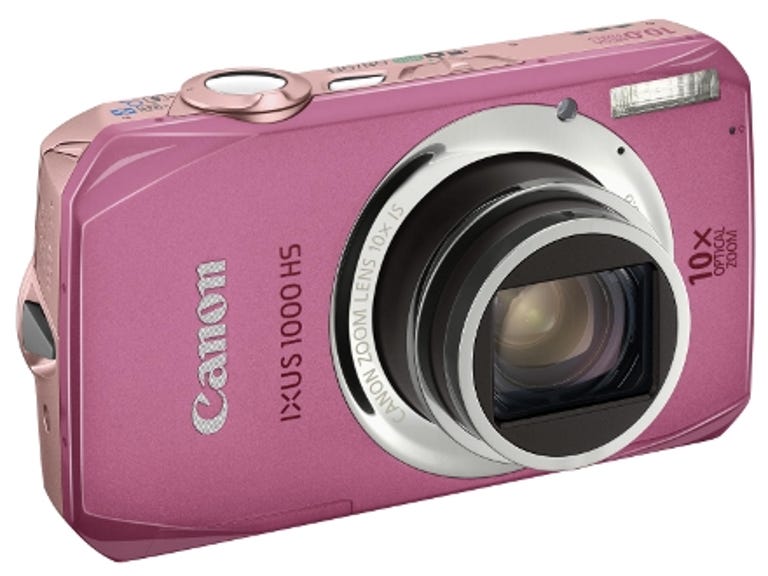 Why You Can Trust CNET
Why You Can Trust CNET Canon IXUS 1000 HS review: Canon IXUS 1000 HS
The Canon IXUS 1000 HS is another competent entry in the long-zooming compact-camera arena. There's little that lifts the 1000 above its ever-swelling pack of rivals, however.
Canon has built the IXUS 1000 HS to celebrate ten years of the immensely popular IXUS brand. To match the anniversary, this compact camera has a 10-megapixel resolution and a 10x zoom. In fact, Canon claims it's currently the world's slimmest camera to pack in a zoom of that length. But is this snapper any good? It's available now for around £270.
The Good
The Bad
The Bottom Line
Kevlar camera
With its shiny surfaces and angular edges, the 1000 looks almost armour-plated, even though it's mainly made of plastic. It's portable, measuring 101 by 59 by 22mm. The buttons and controls are large but awkwardly angular. The large shutter release is encircled by a zoom lever and thumb-operated scroll wheel, which you'll either love or hate.
In offering a broad focal range, equivalent to 36-360mm, the 1000 competes with Panasonic's Lumix TZ series and a growing army of compact rivals that offer a long zoom range. If you're used to a 3x or 5x zoom, you won't want to go back after taking a camera like the 1000 for a spin.

The camera powers up for action in around 2 seconds, and takes a moment or two to determine focus and exposure with a half press of the shutter-release button. Highest-resolution images are committed to memory in around 2 seconds. All these times are what we'd expect from a snapshot camera in this price range.
Against the grain
The 'HS' in the name stands for 'high sensitivity'. Canon claims the result of the camera's 1/2.3-inch CMOS chip and Digic 4 processor is 60 per cent less noise at each ISO setting than you get from cameras without the HS system. Up to ISO 3,200 is offered at full resolution, but you can go up to ISO 6,400 if you accept a drop in resolution, down to 2.5 megapixels.
The 1000 has no hand grip to speak of, so, built-in image stabilisation or not, it's hard to prevent blur resulting from camera shake when shooting interiors without a flash.
The rear of the camera is almost entirely swallowed up by a widescreen-ratio, 76mm (3-inch), 230,000-dot LCD screen, via which images are composed and reviewed. In the absence of an optical viewfinder, it's fit for purpose, although a more glaring omission is a dedicated delete control -- users instead have to go through many tiers of menus to banish duff shots.
The wider screen best suits the camera's video capabilities. Black bands crop either edge of the screen when shooting in normal 4:3-ratio stills mode, but the full width of the monitor can be utilised when replaying video clips. A dedicated video button sits on the top right of the backplate, falling readily under the thumb.
1080p video is captured at 24 frames per second and, even more impressively, with stereo sound features. There's also a slow-motion movie mode, shooting footage at 240fps, which is then played back at 30fps, or, for those looking for more creativity still, a miniature mode can also be used when shooting video. A mini-HDMI output is provided so you can hook the camera up to a TV. There's a separate AV/USB port under a plastic flap on the camera's side.
If you want to capture action sequences, you can rattle off 3.7 photos per second at maximum resolution. The rate can be increased to 8.8fps if you accept a drop in resolution to 2.5 megapixels.
Smart on the inside
There's not much that's overly complex when it comes to using this camera. Most users will probably leave it on its default smart-auto setting and simply snap away. This mode compares the scene or subject before the camera with 28 pre-optimised settings and, theoretically, selects the right one. It's a useful tool for those who'd rather concentrate on their subject than fiddle around with settings.
More fun can be had, however, if you dip into some of the camera's on-board digital effects, including the fish-eye and miniature settings. If you're really lazy, though, you'll appreciate the smart-shutter mode that automatically fires the shutter when the camera detects a subject smiling or winking.
Picture-wise, the 1000 delivers the warm, saturated colours we're used to seeing from Canon, and, when there's plenty of light around, there's plenty of detail to go with it.
A pleasant surprise is that Canon's claims for improved image performance in low light appear to be based in fact. Images up to and including ISO 3,200 are almost noise-free, although detail inevitably begins to soften at higher settings.
A weakness of the camera, however, is its battery life of just 150 shots, which is poor by current standards.
Verdict
Anyone looking for an uncomplicated snapper, with a decent resolution and a whopper of a zoom, could do far worse than check out the Canon IXUS 1000 HS. It's not especially innovative or exciting, but it's another solid snapper from Canon.
Edited by Charles Kloet
